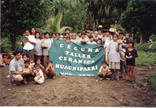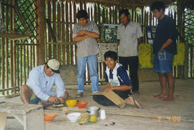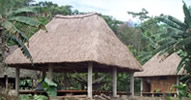Huachiperi Cultural Heritage, Education and Preservation Project
We are currently seeking
support for Centro Wanamey's Youth education (8-10 yrs. kids
of “Huachi” descent) in the
traditional use of medicinal herbs and plants, language preservation
(only a handful of elders are currently fluent in this endangered
language)
Completed projects include the Project for the Preservation of Traditional
Medicine and Arts of the Huachipayri Culture, including the Art
of Hand-Woven Bolsas, Taller de Cerámica
Huachipayri, and Traditional Medicine and Spirituality.
The Art of Hand-Woven Bolsas
In June 2002 at the new Centro Wanamey in Philcopata, Peru, CECUWA (Centro
Cultural Wanamey) conducted the third cultural preservation workshop of
traditional Huachipayri arts and crafts, "The Art of Hand-Woven Bolsas", "Jempu" as
they are called in Huachipayri, for women and children from the villages
of Qeros and Huacaria.
Several of the elder women from Q'eros and Huacaria acted as instructors
during the weekend for the younger women and girls many of whom had no
knowledge of "how to make" the woven shoulder bags. The bags
are very strong and are used to carry fruit from the forest, yucca and
other vegetables from the chacras and other personal uses. In addition,
the bags can be sold to tourists visiting Philcopata for additional income.
The Course teachings included
- Identifying the correct trees from which to obtain the bark
for weaving
- Preparation of the fibrous bark material
- Weaving the baskets utilizing hands, feet and toes!
The Goals
Besides preserving the art of bolsa weaving, the Course increased the
baseline number of persons well-trained in the practice. This increases
the chances of future survival of this ancient art!
Taller de Cerámica Huachipayri
Workshop in the Traditional
Ceramics of the Huachipayri Culture
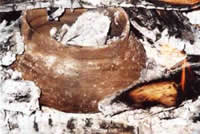
During the Autumn of 2001, Living Bridges Foundation sponsored a project
of CECUWA (Centro Wanamey Foundation) to train thirty youth of the
village of Huacaria (ethnic Machigenga) and from Qeros (ethnic Huachipayri)
in the traditional methods of construction of ceramics both for home
and ornamental use and for sale to local tourists. The "art of ceramics" was
currently known well by only one elder woman from Q'eros. It was
feared that without utilizing her knowledge, that the art would be lost
to the remaining members of the culture. During the workshop, which was
held in the village of Huacaria, the elder woman demonstrated the gathering
constructing and firing and painting of ceramic ware
.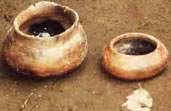
Traditional Medicine and Amazon Spirituality Project for the Huachipayri
Nation of Peru
During the month of May 2001, Living Bridges funded a project offered
by CECUWA, Cultural Center Wanamey, directed by the son of Don Alejandro
Darikiking Jahuranchi, Joel Jahuranchi. The project was centered
on training a group of youth aged 15 to thirty years from the Huachipaeri
community of Qeros in the theoretical and traditional practical knowledge
of the ethnomedicine of this Amazon region.

History
The need to train youth in the use of traditional plant and spiritual
"medicine" has been well established. During the last five decades
cultural exchange with the outside world in the form of religion and commerce
has greatly impacted both the interest in and possibilities for training.
Both the work of AMETRA (Application of Traditional Medicine) in 1986
and FENAMAD (Native Federation of the River Mother and Flowing) in 1991
had previously developed activites in this region with the objective of "revaluation" of
traditional medicine and in the case of the latter, with the publication
of a small manual on medicinal plants and their uses.
Most recently the Shamans Encounters sponsored by Pro-Naturaleza and Tropical
Rainforest Coalition have increased the interest and involvement of the
remaining elder teachers from the Huachpaeri tribe and other tribal ethnic
members from the extended bio-region in the training of the Youth.
Activities and Methods
The thirty youth participating in the training workshop were divided into
two groups each facilitated by an elder male Maestros. The Shamans
of the Shamans Confederation refer to themselves as Maestros. The
workshops held in the actual forest areas focused on identifying
and teaching about the healing properties of various plants and actually
practicing the application of "cures".
Results
The workshop was well appreciated by all those youth in attendance. It
is hoped that other trainings with the youth will continue to inspire
them to uphold the original values of their cultures and to foster the
revived use of medicinal plants and "cures" for everyday ailments.
|



